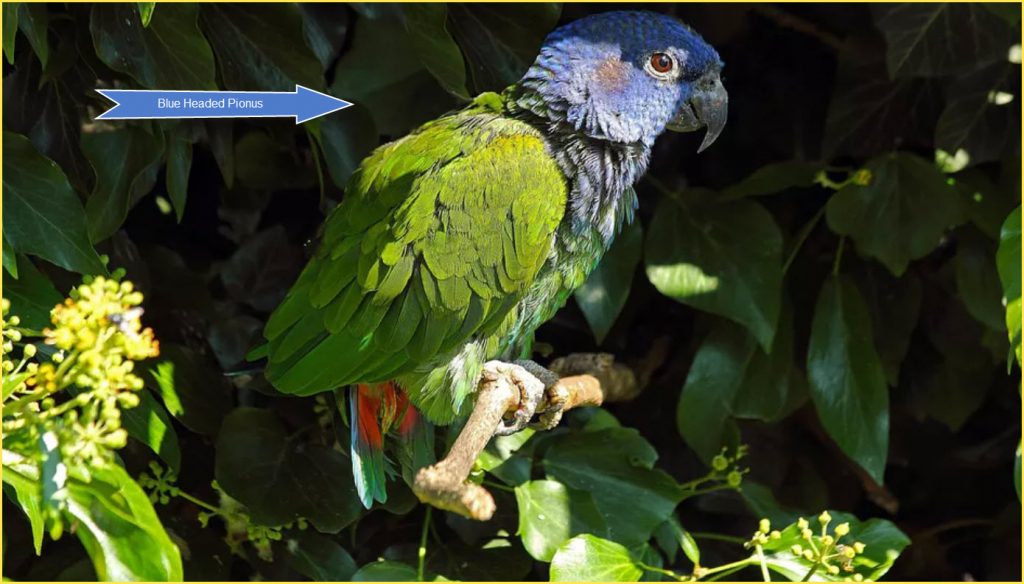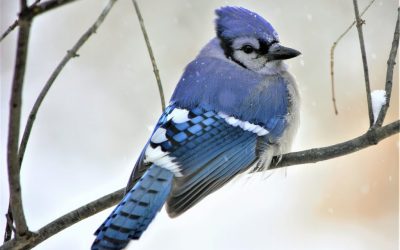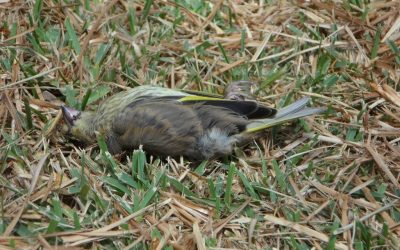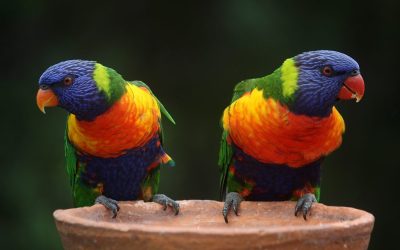
For their colorful and eye catching feathers ,these birds are called Blue Headed Pionus or Blue Headed Parrot.Their scientific name is Pionis menstrus.
Blue Headed Pionus Origin
The origin of wild blue headed pionus is in the tropical areas of Cost Rica, Central America and South America. As this bird has been kept in captivity for long time.This has made Blue Headed Pionus a beloved pet in homes all over the world.
Size
Blue Headed Pionus is a medium to large sized parrot. At adult age, these types of birds reach lengths of up to 12 inches when they are measured from beak to tail. They are relatively chubby parrots, like other types of Pionus, and adults normally weigh from 8 to 9 ounces .
Average Lifespan
A healthy Blue Headed Pionus can live up to forty years in captivity. Some even live longer.Due to their very long lifespan and the attention that is needed when caring for a pet bird.owners are strictly warned to do plenty of research and they should make their selves ready to commit to caring for these birds before dopting.
Temperament
The Blue Headed Pionus, like other Pionus parrots,are independent while at the same time remaining closely bonded and devoted to their owners. They love interacting with their family members, playing games, and amusing themselves with toys. Many owners have noted that they have easygoing, gentle personalities and that they do not bite like other species, although they are certainly capable of doing so if they take an inclination. These parrots are also reported to be among the quieter types of parrot species.
Blue Headed Pionus Colors
The beautiful plumage of the Blue Headed Pionus is responsible for the bird’s name as well as its immense popularity among pet owners. The body of these birds is mainly a bright green color, with bronze overtones on the upper parts of the wings. The head is a bright and brilliant blue color, and this continues to the mid part of the bird’s breast. They have darker, dusty colored circles on each of their cheeks, and red feathers on the undersides of their tails, as all Pionus parrots do. Another distinctive feature of these birds is a characteristic red patch on the upper mandible of the beak.
Feeding
Like all pet birds,full attention must be paid to the Blue Headed Pionus diet. In custody, these birds do best when they are feeded with a high quality commercial pelleted diet,added with a seed mix prepared for large birds.These foods must always be served in conjunction with a plenty of fresh fruits and vegetables to make sure that they are takig the proper amount of viatmins.These parrots also enjoy eating home made treats like bird bread recipes,sprouts etc.
Exercise
These parrots are very energetic.They require many rooms to play and exercise.So,any one who want to keep these birds,they should make sure that they have time in their routines to give their pets three to four hours out side of the cage daily.When your bird is out of the cage,this playtime should be supervised strictly.
Blue Headed Pionus as Pets
They are amongst popular pet birds for many years.If you are thinking about adopting this parrot, then you must have to do alot of research to make sure that your living style is suited for these birds.For this purpose,you can contact a local breeder or an aviculture society in your area and talk with people who have experience keeping and raising these parrots. They will guide you to the proper resources which will help you to decide if a Blue Headed Pionus is the right bird for you.
How to Care for Pet Birds in Cold Weather
When the weather outside gets cold, it can create trouble for pet birds. Because most pet bird species hail from geographic areas that have warm, tropical climates, a drop in temperature can be destructive to their comfort and health, even if you keep your bird...
How to deal with the loss of a pet bird
It's an uncomfortable but inevitable part of pet ownership—there comes a time that your pet will die, and you will have to say goodbye to the companion that you've spent so much time with. People have different ways of dealing with grief and loss.There arefew...
How to stay healthy around pet birds
Before purchasing or adopting a pet bird, make sure that bird is the right type of pet for your family. Know that many pet birds have a very long life span. Some parrots can live for 20 years or longer. Birds require special care and can sometimes carry germs...
How to find a good bird sitter
It's not always possible to take a break with your bird, even if you'd really prefer to travel with your feathered companion in tow. Because of this, and the fact that it can be difficult to travel with any type of pet, there has been an influx of small pet sitting...
How to Train Your Dog to Be Around Pet Birds
Whether you already have a dog and you are thinking to keep a pet bird,or you already have a bird and you are thinking to keep a pet dog.You will need a bit of work to attach them into the same home.It can be challenging to train dogs and birds to get along.But it so...
Rainbow Lorikeets: Bird Species Profile
Rainbow Lorikeets are very sweet natured and vibrantly brilliant birds.They have long life.They love to be in the midst of the action.This bird loves to play whenever its favorite person is around.This bird is not shy.It will let you know when it wants attention.If...







Recent Comments